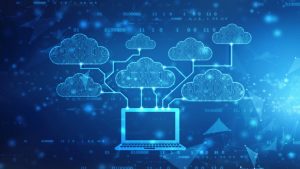Cloud computing has transformed the business world in its entirety. It is shaping the market and the way organizations do business and will continue to do so. There has been rapid development as businesses strive towards digitizing their operations and expanding their IT departments. They have also started rapidly adopting cloud computing in order to boost their growth and efficiency. It is essential to stay up to date with the current trends.
2022 has been no exception with new trends than the year before in the world of cloud computing. The numerous advantages of cloud computing are well known and more and more businesses are moving into this realm to further their growth and profit margins. There are certain trends to watch out for in order to stay ahead of the curve since this is an ever evolving feature of today’s increasingly digital world.
This article will discuss the top 6 trends in cloud computing in the year 2022 which have affected the market and will continue to do so in early 2023. For any business to remain relevant and competitive in the highly competitive status quo, it is vital to watch out for these trends and remain up-to-date with them.
1. Edge Computing:
This is a recent development in data processing in which these operations take place closer to the sources of data which saves up on bandwidth and response times. This ‘edge’ is usually located at the network’s edge where end devices are connected to the network. Each of these edge servers have distinct computing, storage and networking capacities. Similarly each device possesses the functions for:
- Network Switching
- Network Routing
- Security
- Load balancing
It must be noted that edge computing is not to replace cloud computing. Rather, cloud and edge computing both complement each other and this combination is a trend that has increased this year rapidly. This combination enables the benefits of the cloud but also provides the following benefits:
- Almost instant data processing
- Lower bandwidth needs
- No recess between response times
- Volumes of transmitted data are decreased
Edge computing will continue to be vital in the following year like it was in 2022.
2. Increase in Serverless Computing:
This is a cloud model in which the cloud provider deals with underlying infrastructure and deploys computing resources in line with the needs. This way, the user does not have to deal with either of these features. This offers numerous benefits to businesses which include, but are not limited to, the following:
- Pay-as-you-go
- In-house IT department does not need to manage servers
- In-house developers can focus more on innovation and core activities
- Scalability
- Lower chances of back end failures
Serverless computing continues to grow and 2022 was no exception. It is projected to increase by 22.6% in the next four years. It increases agility and lower expenses which are always attractive features for businesses.
3. More AI & ML Adoptions:
All artificial intelligence and machine learning endeavors and the platforms that accommodate them require high bandwidth and processing power. Both of these can be performed best on the cloud than in any other setting. There is a complementary nature associated with this combination. Cloud technology decreases costs and increases accessibility of artificial intelligence. Artificial intelligence, on the other hand, enables cloud services to manage their data and also helps them by providing valuable insights like user behavior, trends, likes etc. Moreover cloud computing is playing a major role in two emerging AI technologies:
- Creative Algorithms: Trains other AI programs and uses machine learning to create anything e.g. art etc.
- Language Modelling: Accurately understands human languages and shaping B2C interactions.
Cloud computing will play a major and indispensable role in the growth of these technologies and will benefit not only big but also small and medium businesses by making top AI solutions more accessible and cost effective. Without cloud, AI and ML technologies become inaccessible and expensive for smaller businesses. This trend has risen in 2022 and is expected to continue in the following years as well.
4. Kubernetes & Blockchain:
Blockchain is a technology in which data is recorded in a digital ledger without the need of a central authority and this ledger is free from cyber threats and tampering. However, there are problems with scaling when it comes to big data management and storage. This is where Kubernetes come in. It is an open source system specifically for scaling apps and automating deployments rapidly and can, therefore, scale blockchain environments as well. Using cloud based Kubernetes clusters are being used increasingly as all businesses to scale and solve the complex problems associated with blockchain environments. This might soon become the standard for all businesses operating with blockchain technology which in itself is a game changer. With cloud computing, this trend has risen in 2022 and will continue to do so in subsequent years.
5. Stress on Security of the Cloud:
Concerns and risks associated with compliance, privacy and integration are major roadblocks with regards to adoptions of the cloud by more businesses. Therefore, this year we have seen an increase in emphasis on cloud security and the demand for the following two security features has increased:
- Secure Access Service Edge (SASE): Allows users to easily manage access between cloud applications, IT which on the premises and end user devices.
- Cloud-based Disaster Recovery (DR): This enables organizations to back up their data and have a contingency IT environment for use in case the primary infrastructure crashes or goes down.
Security will always remain a top concern as the world becomes digitized and in 2022 we have seen a trend in the above mentioned two security features in cloud computing which have increased in demand. This will enable more and more businesses to shift to the cloud in the following years.
6. Gaming, AR and VR Developments in the Cloud:
E-gaming has rapidly increased in the past two decades and is expected to increase even more quickly in the following years. Cloud gaming allows gamers to play video games based on remote servers directly from their devices. This remote playing allows them to:
- Avoid investing in any hardware
- Experience no lag
- Play without the need for storage space on their devices
- Ensure compatibility across all devices for all players
- Enjoy better security due to lack of piracy
The industry leaders like Google, Microsoft etc. have and are developing their cloud gaming spaces rapidly so this trend is expected to grow rapidly in the following years more than it is right now in 2022.
Conclusion:
Cloud is rapidly becoming a necessity with every passing year. There will come a time when it will no longer be an option and everything will be based on it. As the world moves towards it, everyone must in order to stay relevant and competitive in this increasingly competitive market. One way to stay ahead is to identify trends in the cloud computing space every year and keep up to date with the latest developments to establish and, subsequently, manage your position ahead of the curve. Migrate your business operations to the cloud if you have not already and stay current or risk falling behind the rest of the business world.




